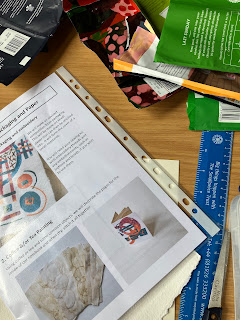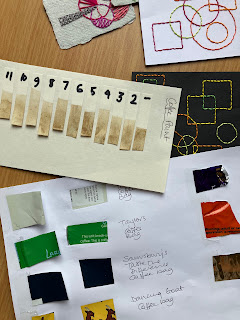We met in Haxby on 5th July and were pleased to welcome several visitors who had attended our recent exhibition and been tempted to join us.
A new set of stitch clubs kicked off. Sally got a large group started with Stitching with Packaging and Paper. Sally had provided project packs and the group were very intrigued by the processes and materials involved. They made marks on paper with coffee stain (to be the pages of a book) and cut collages out of foiled coffee packaging. These were ironed onto khadi paper and were then ready to be embellished. The process was great fun and by the end of the morning members had their insert pages drying and were able to start stitching onto their book covers.
Sally's stitch club materials and samples
Packaging being collaged and stitched
On the other side of the hall Angela had provided wool and mono canvas squares for a group who were learning and/or improving their canvas work. Over three weeks they will widen their stitch repertoire and in the first week they learned diagonal stitch, shaded diagonal tent stitch and Rhode stitch. The first step was to decide on a colour scheme and prepare the design. As with any counted work, concentration and attention to detail was required so members were kept very focused and the morning sped by.
Workshop materials for Canvas work
Close up of Angela's sampler
The first week of stitch clubs involves a lot of preparation and we look forward to seeing work progressing next time. Stitch clubs are not compulsory! Members can work on their own projects and be companionable or simply work quietly. Anne was 'playing' with different stitches in shades of blue on a printed fabric panel. She intended to make two book covers out of the completed work - practical and beautiful gifts for the intended recipients.
Anne's tonal stitched sampler
Jessica Aldred - Traditional Embroidery in a Modern World
Our afternoon speaker was the very talented Jessica Aldred who was a Royal School of Needlework apprentice 2001-2004 and has since applied her professional embroidery skills to a wide range of projects. She gave us a brief history of the RSN from its origins in 1872 and the different routes into professional embroidery it offered. During her illustrated talk she explained how modern professional embroidery features in Haute Couture, Wedding clothing, Film and Television and Military and Ceremonial settings. Indeed she herself and her fellow RSN trained embroiderers working in the RSN Embroidery Studio have created many stunning pieces and we enjoyed hearing her talk about a selection of these, including her contribution to hand embroidering bespoke lace on the wedding dress of HRH The Duchess of Cambridge. She had also worked in Costume at the Royal Opera House and taught embroidery alongside undertaking commissioned work.
Jessica has a wide range of personal interests and uses her considerable skills and enthusiasm to inspire others. She has worked in prisons with FIne Cell Work, teaching prisoners embroidery to help them earn a little money, develop skills and appreciate the mental health benefits of hand work. She also works for a charity providing creative education to learning disabled and autistic adults as well as running her business, House of Heyday. In 2011 Jessica co-authored a book 'Adventures in Needlework' with Emily Peacock who designs contemporary needlepoint.
Jessica brought along a selection of her work, some she had made during her RSN apprenticeship and some to illustrate her more recent work, including a ribbon work kit designed for the V&A Museum as part of their exhibition 'Frida Kahlo: Making Her Self Up'. Clearly she is wonderfully skillful and we admired her exquisite stitching.
Jessica's fabulous hoop embroideries
Jessica's exquisite goldwork
Jessica's fine whitework
Award winning embroidered banner for Fine Cell Work
Designer, Embroiderer and Artist Jessica works as House of Heyday and further information is on her website which is houseofheyday.co.uk
Our next meeting
If you are interested in embroidery or any form of sewing and stitching, or if you would like to hear one of our 'afternoon speakers' (check the Programme for details) do please come along. We will meet on Saturday 9th August in Haxby Memorial Hall, York and visitors and new members are welcome.




















































